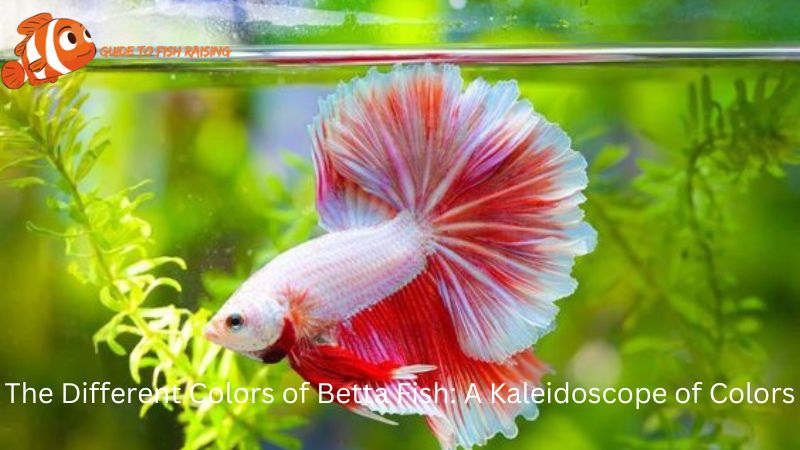Betta fish, also known as Siamese fighting fish, are celebrated for their striking beauty and vibrant colors. These small, freshwater fish are native to Southeast Asia, where they have been bred for their vivid hues and elaborate fins. Betta fish are available in a wide range of colors, each with its own unique charm and appeal. In this article, Guide to Fish Raising will explore the different colors of betta fish, how these colors are produced, and what mak
Table of contents
ToggleUnderstanding Betta Fish Colors
The color of a betta fish is determined by a combination of genetic factors and selective breeding. Betta fish have three layers of color cells, known as chromatophores, which contribute to their overall coloration:
- Iridescent Cells (Iridophores): These cells reflect light and create shimmering, metallic colors such as blue and green.
- Pigment Cells (Chromatophores): These cells contain pigments that produce red, yellow, black, and brown colors.
- Guanine Cells (Leucophores): These cells contain guanine crystals that reflect light and create a white or silver appearance.
Through selective breeding, betta fish breeders have been able to enhance and combine these color layers to produce a stunning array of colors and patterns.
The Common Different Colors of Betta Fish
Red Betta Fish
Red is one of the most common and striking colors found in betta fish. Red bettas are known for their intense, solid coloration that can range from a deep crimson to a bright cherry red. This color is often associated with strength and vitality.
Blue Betta Fish
Blue bettas are highly sought after for their rich, vibrant hues. The blue coloration can vary from a light, sky blue to a deep, royal blue. Some blue bettas also exhibit iridescent scales that create a shimmering effect in the light.
Green Betta Fish
Green bettas are less common but equally captivating. Their green coloration can range from a subtle, mossy green to a bright, emerald green. Like blue bettas, green bettas often have iridescent scales that enhance their appearance.
Yellow Betta Fish
Yellow bettas, also known as “non-red” bettas, display a cheerful and sunny color. Their yellow coloration can vary from a pale, buttery yellow to a bright, lemon yellow. This color is often associated with happiness and positivity.
Orange Betta Fish
Orange bettas are relatively rare and can exhibit a range of shades from a soft, peachy orange to a vibrant, tangerine orange. This color is a result of combining red and yellow pigments.
Black Betta Fish
Black bettas are known for their dramatic and elegant appearance. Their coloration can range from a dark, charcoal black to a deep, velvety black. Some black bettas may also have hints of blue or green iridescence.
White Betta Fish
White bettas are often referred to as “albino” or “opaque” bettas. They have a pure, pristine appearance and can exhibit a range of shades from a translucent, milky white to a solid, snow white.
Purple Betta Fish
Purple bettas are relatively rare and highly prized for their unique and captivating coloration. Their purple hues can vary from a soft lavender to a deep, royal purple. This color is often achieved through selective breeding of blue and red bettas.
Pink Betta Fish
Pink bettas have a delicate and charming appearance. Their pink coloration can range from a pale, blush pink to a more vibrant, rosy pink. This color is often associated with femininity and grace.
Copper Betta Fish
Copper bettas are known for their metallic, bronze-like appearance. Their coloration can range from a warm, reddish-brown to a more golden, copper hue. This color is a result of the iridescent cells reflecting light in a unique way.
Unique Color Patterns in Betta Fish

In addition to their solid colors, betta fish can also exhibit a variety of patterns that add to their visual appeal. Some of the most popular patterns include:
- Bi-color Betta Fish: Bi-color bettas have two distinct colors on their bodies and fins. The body is usually one solid color, while the fins are another. This contrast creates a striking and eye-catching appearance.
- Marble Betta Fish: Marble bettas have a unique and unpredictable pattern that resembles marbled stone. Their coloration can change over time, making each marble betta truly one-of-a-kind.
- Butterfly Betta Fish: Butterfly bettas have a solid color on their body that gradually fades into a different color on the edges of their fins. This pattern creates a beautiful, wing-like effect that is reminiscent of a butterfly’s wings.
- Dragon Betta Fish: Dragon bettas are known for their metallic, armor-like scales that cover their bodies. These scales give them a unique and almost mythical appearance, with colors that can range from red and blue to gold and silver.
- Koi Betta Fish: Koi bettas are named after the colorful koi fish and have a similar pattern of blotches and patches of color. These patterns can include combinations of red, orange, black, and white, creating a striking and vibrant appearance.
- Cambodian Betta Fish: Cambodian bettas have a distinct pattern with a pale, flesh-colored body and brightly colored fins. This pattern creates a striking contrast that highlights the betta’s vibrant fins.
- Wild-type Betta Fish: Wild-type bettas, also known as “plakat” bettas, have coloration and patterns that resemble their wild ancestors. These bettas often have earthy tones such as brown, green, and blue, with a more natural and less flashy appearance.
The Genetics Behind Betta Fish Colors
The color and pattern of a betta fish are determined by its genetics. Betta fish have a complex genetic makeup that includes multiple genes responsible for their coloration. These genes interact in various ways, resulting in the wide range of colors and patterns seen in bettas.
Some of the key genetic factors that influence betta fish coloration include:
- Pigment Genes: These genes control the production of pigments such as red, yellow, black, and blue. Different combinations of these pigments create the diverse colors seen in bettas.
- Iridescence Genes: These genes affect the production of iridescent cells that create metallic and shimmering colors. The amount and distribution of iridescent cells can influence the overall appearance of the betta.
- Pattern Genes: These genes determine the distribution of colors and patterns on the betta’s body and fins. Different pattern genes can create bi-color, marble, butterfly, and other unique patterns.
- Modifier Genes: These genes can enhance or dilute the expression of other color and pattern genes. For example, a modifier gene may intensify the red coloration or create a paler version of a color.
Selecting and Caring for Betta Fish Based on Color
When selecting a betta fish, many enthusiasts choose their fish based on color and pattern preferences. Here are some tips for selecting and caring for betta fish based on their coloration:
Selecting a Betta Fish
When choosing a betta fish, consider the color and pattern that appeals to you the most. Look for a fish with vibrant colors, clear eyes, and active behavior. Avoid bettas with dull colors, clamped fins, or signs of illness.
Tank Setup
Provide a suitable tank setup that complements the coloration of your betta. A tank with proper lighting, plants, and decorations can enhance the beauty of your betta’s colors.
Diet and Nutrition
A balanced diet is essential for maintaining the vibrant colors of your betta fish. High-quality betta pellets, live or frozen foods, and occasional treats can help keep your betta healthy and colorful.
Water Quality
Clean water is crucial for the health and coloration of your betta fish. Regular water changes, proper filtration, and maintaining stable water parameters can prevent stress and enhance your betta’s colors.
Temperature and Lighting
Maintain a stable water temperature between 76°F and 82°F (24°C to 28°C) and provide proper lighting to showcase your betta’s colors. Avoid sudden changes in temperature and lighting, as these can stress your betta and affect its coloration.
Conclusion
The different colors of betta fish make them one of the most visually captivating species in the aquarium hobby. From the intense reds and blues to the rare purples and coppers, each betta fish has its own unique beauty and charm. Understanding the genetic factors and selective breeding practices that produce these vibrant colors can help you appreciate and care for your betta fish even more.
By providing a suitable environment, proper nutrition, and attentive care, you can ensure that your betta fish remains healthy and displays its stunning colors to the fullest. Whether you are a seasoned betta enthusiast or a new owner, the diverse colors and patterns of betta fish offer endless opportunities for enjoyment and admiration.





